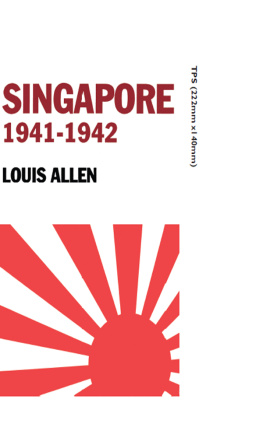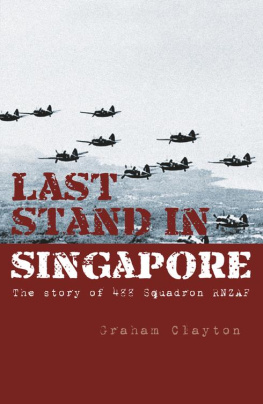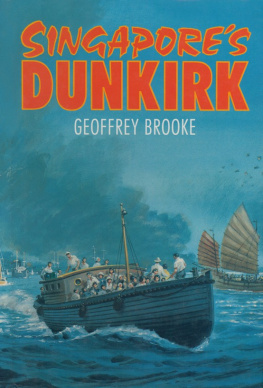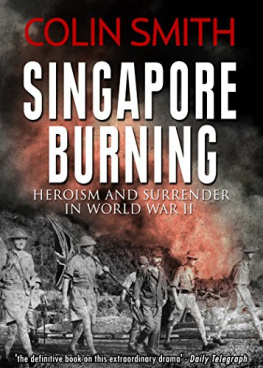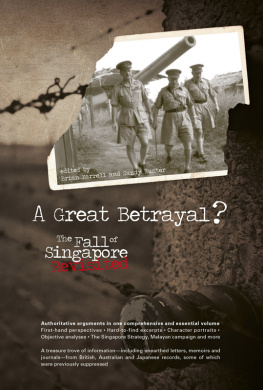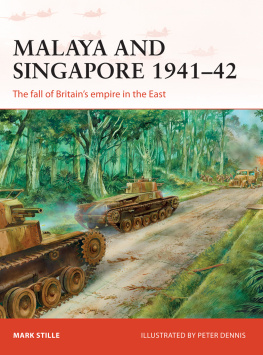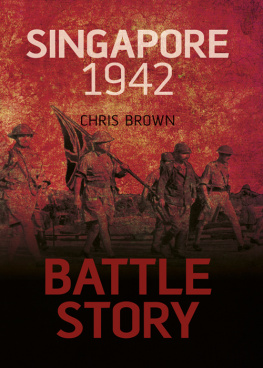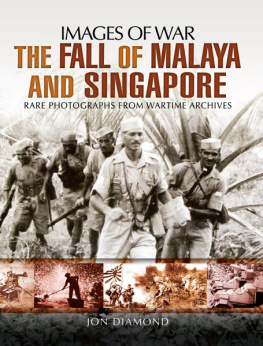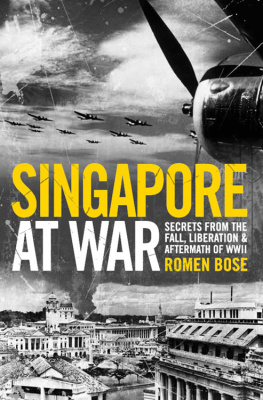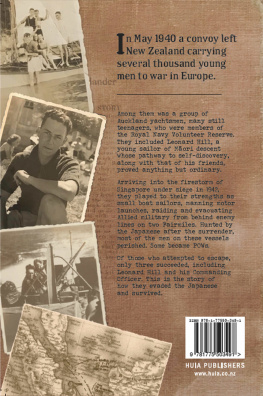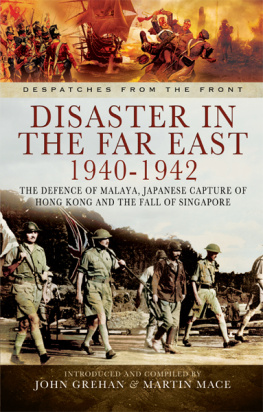ROUTLEDGE LIBRARY EDITIONS: WORLD WAR II IN ASIA
Volume 3
The Fall of Singapore
First published in 1983 by Methuen Australia Pty Ltd
This edition first published in 2015
by Routledge
2 Park Square, Milton Park, Abingdon, Oxon OX14 4RN
and by Routledge
711 Third Avenue, New York, NY 10017
Routledge is an imprint of the Taylor & Francis Group, an informa business
1983 Timothy Hall
All rights reserved. No part of this book may be reprinted or reproduced or utilised in any form or by any electronic, mechanical, or other means, now known or hereafter invented, including photocopying and recording, or in any information storage or retrieval system, without permission in writing from the publishers.
Trademark notice: Product or corporate names may be trademarks or registered trademarks, and are used only for identification and explanation without intent to infringe.
British Library Cataloguing in Publication Data
A catalogue record for this book is available from the British Library
ISBN: 978-1-138-89912-4 (Set)
ISBN: 978-1-315-68968-5 (Set) (ebk)
ISBN: 978-1-138-91242-7 (Volume 3) (hbk)
ISBN: 978-1-315-69193-0 (Volume 3) (ebk)
Publishers Note
The publisher has gone to great lengths to ensure the quality of this reprint but points out that some imperfections in the original copies may be apparent.
Disclaimer
The publisher has made every effort to trace copyright holders and would welcome correspondence from those they have been unable to trace.

The Fall of Singapore
Timothy Hall
Methuen Australia
For my godfather, Alan Simpson
For my godfather, Alan Simpson
Devised and produced by Taylor-Type
Publications (Australia) Pty Ltd
First published in 1983 by
Methuen Australia Pty Ltd
44 Waterloo Road, North Ryde 2113
150 Burwood Road, Hawthorn 3122
Cnr Allenby and Leichhardt Streets, Spring Hill 4000
1/19 York Street, Subiaco 6008
Timothy Hall 1983
This book is copyright. Apart from
any fair dealing for the purposes
of private study, research, criticism
or review, as permitted under the
Copyright Act, no part may be
reproduced by any process without
written permission. Inquiries
should be addressed to Methuen Australia Pty Ltd.
National Library of Australia
Cataloguing-in-Publication data
Hall, Timothy
The fall of Singapore.
Includes index.
ISBN 0 454 00433 8.
1. World War, 1939-1945 Campaigns Asia,
Southeastern. 2. Singapore Siege, 1942.
I. Title.
940.5425
Typesetting by Redi-Set Photosetters Pty Ltd, Sydney
Designed by M.D. Camp
Printed in Hong Kong
Contents
Acknowledgements
I am grateful to many who served in the Malayan Campaign, and their families, who gave me their time and who so kindly made available to me diaries and letters. In Singapore I was given every assistance by the Singapore Government and I owe a special debt to Singapore Airlines who carried me in both directions with much friendliness and help.
Mrs Cynthia Koek enthralled me with her memories of the days before and after the capitulation.
The Australian War Memorial was, as always, invaluable. If any errors have crept in, they are my responsibility and mine alone.
Extending down from Burma and Thailand until it almost touches the great island of Sumatra is the long narrow appendix of land which is the Malay Peninsula. Since ancient times it has formed a physical and cultural link between the mainland and islands of the East Indies.
Along the length of its spine runs a mountain range, rising at its peak to 2287 m, and covered for the most part with dense jungle. On either side of these mountains, the land levels off into the lowlying coastal plains. Monsoon rains, which give Malaya an annual rainfall of 2500 mm, most of it falling in torrential downpours, have resulted in dense evergreen rainforests which even today cover 60 per cent of the country.
Flying over Malaya, it is hard to see why this small country hardly as large as England and Wales should have been prized by anyone, but beneath the green canopy lay boundless wealth. As the world geared up for war in 1939 and 1940, Malaya was the worlds largest producer of two of the most vital primary products in any war, tin and rubber. And in the production of palm oil, a valuable oil used for making soap, candles and lubricating grease, Malaya was second only to Nigeria.
At the very toe of the peninsula, dominating one of the most important trade routes in the world, lay the Crown Colony island of Singapore, the visible symbol of the power and invincibility of the British Empire in the Far East.
For the Japanese, scheming to extend their hegemony throughout the Far East, the subjugation of Malaya and Singapore was a key move in their elaborate game. The avowed Japanese aim was to establish what they termed euphemistically The Greater East-Asia Co-Prosperity Sphere, an economic system independent of sterling, the American dollar and the rest of the world, with Japan herself, of course, as its nucleus. At all times this conception of becoming a master race was common to the German and the Japanese leaders and coloured their entire strategy.
Singapore was singled out to be the capital of the Co-Prosperity Spheres southern region and was to be the chief military supply base in the area. In the process, its subjugation would see the removal once and for all of the most visible and obnoxious bastion of British domination in the area.
For Australia the island had a special significance because its continuing role as an allied base was crucial to the very existence of Australia itself. If the Japanese held Singapore, they would also control the sea lanes; and if they controlled the sea lanes, they could starve Australia into submission without a single Japanese life being risked in an armed invasion.
Ever since 1819 when Thomas Stamford Raffles had acquired the steaming jungle island for Great Britain, it was assumed that any threat to Singapore would come from the sea. The mountainous jungle of Malaya to the north and beyond that again in Thailand and Burma, seemed to Britains strategists to be a natural defence that no man-made fortifications could improve upon.
Britain therefore concentrated on constructing a series of elaborate fixed defences which were all aimed at protecting Singapore against an amphibious attack. These defences, including five huge 15-inch naval rifles, six 9.2-inch guns and eighteen 6-inch guns, made the expression Fortress seem entirely appropriate, and the phrase Fortress of Singapore slipped effortlessly into the vocabulary.
After World War I, when Japan was perceived as a major threat to Britains possessions in the Far East, it was decided to strengthen its position by the construction of a huge naval base. It would occupy a large part of the northern coast of Singapore Island and cost $60 million. This base, with its huge dockyard, would be the key to Britains naval supremacy in the Far East. Sprawling over some 60 sq km, it was large enough to take the entire British fleet at the same time and it included two enormous 50 000 tonne dry docks.




